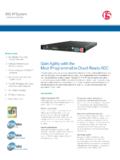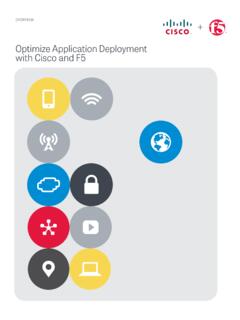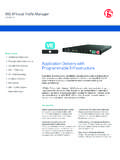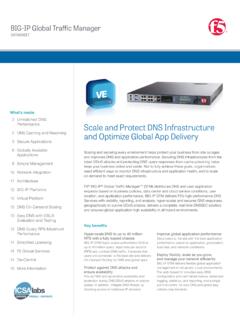Transcription of Load Balancing 101: Nuts and Bolts | F5 White Paper
1 White PaperLoad Balancing 101: nuts and BoltsLoad Balancing technology is the basis on which today s Application Delivery Controllers operate. But the pervasiveness of load Balancing technology does not mean it is universally understood, nor is it typically considered from anything other than a basic, network-centric viewpoint. To maximize its benefits, organizations should understand both the basics and nuances of load Balancing . by KJ (Ken) Salchow, Jr. Sr. Manager, Technical Marketing and Syndication2 White PaperLoad Balancing 101: nuts and BoltsContentsIntroduction 3 Basic load Balancing Terminology 3 Node, Host, Member, and Server 3 Pool, Cluster, and Farm 4 Virtual Server 5 Putting It All Together 5 load Balancing Basics 6 The load Balancing Decision 7To load Balance or Not to load Balance?
2 9 Conclusion 103 White PaperLoad Balancing 101: nuts and BoltsIntroduction load Balancing got its start in the form of network-based load Balancing hardware. It is the essential foundation on which Application Delivery Controllers (ADCs) operate. The second iteration of purpose-built load Balancing (following application-based proprietary systems) materialized in the form of network-based appliances. These are the true founding fathers of today s ADCs. Because these devices were application-neutral and resided outside of the application servers themselves, they could load balance using straightforward network techniques.
3 In essence, these devices would present a virtual server address to the outside world, and when users attempted to connect, they would forward the connection to the most appropriate real server doing bi-directional network address translation (NAT).ClientInternetWeb ClusterHost: : Host: : Virtual :80 Figure 1: Network-based load Balancing load Balancing Terminology It would certainly help if everyone used the same lexicon; unfortunately, every vendor of load Balancing devices (and, in turn, ADCs) seems to use different terminology. With a little explanation, however, the confusion surrounding this issue can easily be alleviated. Node, Host, Member, and Server Most load balancers have the concept of a node, host, member, or server; some have all four, but they mean different things.
4 There are two basic concepts that they all try to express. One concept usually called a node or server is the idea of the physical server itself that will receive traffic from the load balancer. This is 34 White PaperLoad Balancing 101: nuts and Boltssynonymous with the IP address of the physical server and, in the absence of a load balancer, would be the IP address that the server name (for example, ) would resolve to. For the remainder of this Paper , we will refer to this concept as the second concept is a member (sometimes, unfortunately, also called a node by some manufacturers). A member is usually a little more defined than a server/node in that it includes the TCP port of the actual application that will be receiving traffic.
5 For instance, a server named may resolve to an address of , which represents the server/node, and may have an application (a web server) running on TCP port 80, making the member address :80. Simply put, the member includes the definition of the application port as well as the IP address of the physical server. For the remainder of this Paper , we will refer to this as the all the complication? Because the distinction between a physical server and the application services running on it allows the load balancer to individually interact with the applications rather than the underlying hardware. A host ( ) may have more than one service available (HTTP, FTP, DNS, and so on). By defining each application uniquely ( :80, :21, and :53), the load balancer can apply unique load Balancing and health monitoring (discussed later) based on the services instead of the host.
6 However, there are still times when being able to interact with the host (like low-level health monitoring or when taking a server offline for maintenance) is extremely convenient. Remember, most load Balancing -based technology uses some concept to represent the host, or physical server, and another to represent the services available on it in this case, simply host and services. Pool, Cluster, and Farm load Balancing allows organizations to distribute inbound traffic across multiple back-end destinations. It is therefore a necessity to have the concept of a collection of back-end destinations. Clusters, as we will refer to them herein, although also known as pools or farms, are collections of similar services available on any number of hosts.
7 For instance, all services that offer the company web page would be collected into a cluster called company web page and all services that offer e-commerce services would be collected into a cluster called e-commerce. 5 White PaperLoad Balancing 101: nuts and BoltsThe key element here is that all systems have a collective object that refers to all similar services and makes it easier to work with them as a single unit. This collective object a cluster is almost always made up of services, not hosts. Virtual Server Although not always the case, today there is little dissent about the term virtual server, or virtual. It is important to note that like the definition of services, virtual server usually includes the application port was well as the IP address.
8 The term virtual service would be more in keeping with the IP:Port convention; but because most vendors use virtual server, this Paper will continue using virtual server as well. Putting It All Together Putting all of these concepts together makes up the basic steps in load Balancing . The load balancer presents virtual servers to the outside world. Each virtual server points to a cluster of services that reside on one or more physical : : Host: : Host: : Host: : ServerWeb Cluster: :80 SSL Cluster: :443 Telnet Cluster: :23 Web :80 Telnet Cluster: :23 SSL Cluster: :443 Web ClusterFigure 2: load Balancing comprises four basic concepts virtual servers, clusters, services, and PaperLoad Balancing 101: nuts and BoltsWhile Figure 2 may not be representative of any real-world deployment, it does provide the elemental structure for continuing a discussion about load Balancing basics.
9 load Balancing BasicsWith this common vocabulary established, let s examine the basic load Balancing transaction. As depicted, the load balancer will typically sit in-line between the client and the hosts that provide the services the client wants to use. As with most things in load Balancing , this is not a rule, but more of a best practice in a typical deployment. Let s also assume that the load balancer is already configured with a virtual server that points to a cluster consisting of two service points. In this deployment scenario, it is common for the hosts to have a return route that points back to the load balancer so that return traffic will be processed through it on its way back to the client.
10 The basic load Balancing transaction is as follows: 1. The client attempts to connect with the service on the load balancer. 2. The load balancer accepts the connection, and after deciding which host should receive the connection, changes the destination IP (and possibly port) to match the service of the selected host (note that the source IP of the client is not touched). 3. The host accepts the connection and responds back to the original source, the client, via its default route, the load balancer. 4. The load balancer intercepts the return packet from the host and now changes the source IP (and possible port) to match the virtual server IP and port, and forwards the packet back to the client.









